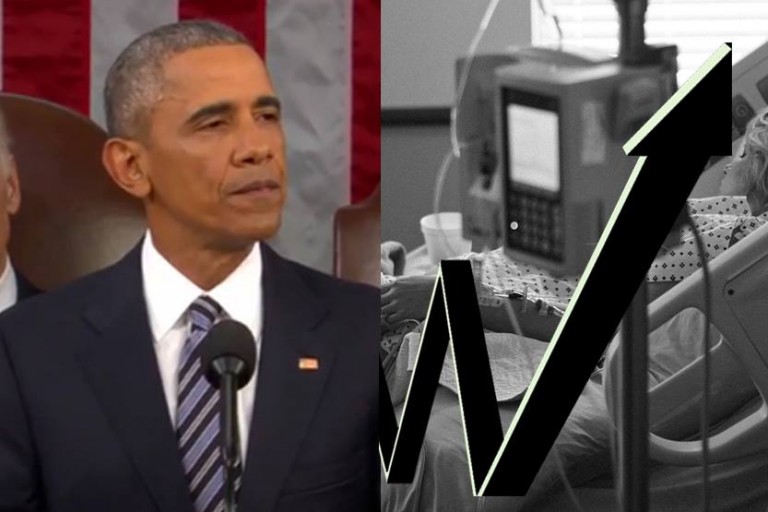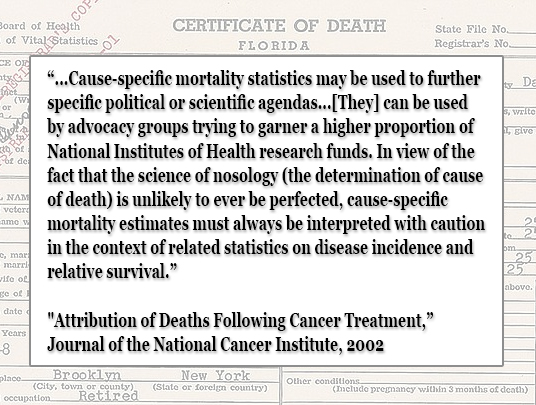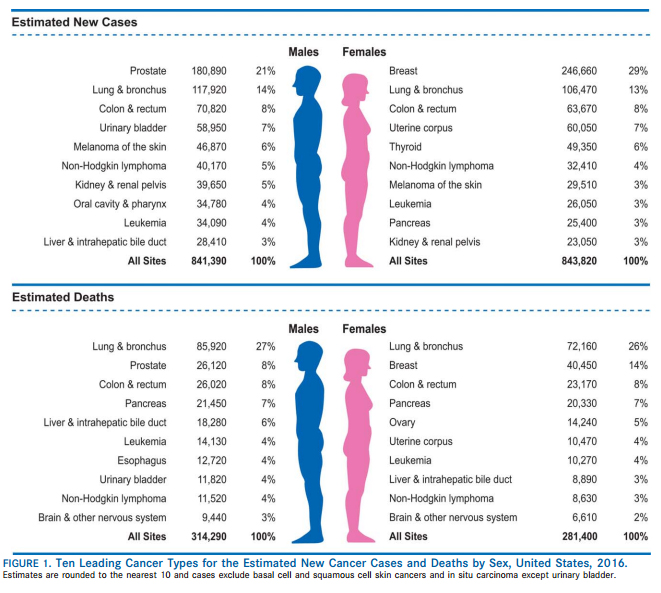Anyone Who Tells You We’re Winning the War on Cancer is Lying Through Their Teeth — Here’s Why
Barack Obama wants to “end” the war on cancer, while mainstream media thinks we’re already winning it. But a closer looks tells a different story.
An article published in CA: A Cancer Journal for Clinicians praises the cancer industry based primarily on one statistic — that there’s been a 23% decrease in the United States’ cancer death rate since 1991. Unfortunately, despite the “good news” articles you may have seen in the media, it’s way too early to celebrate.
While this “23% decrease” reported by the American Cancer Society looks good on paper, a closer look reveals the grim truth about where we really stand in our “battle” against cancer. Further research reveals that we’re a lot farther away than we’ve been lead to believe.
And unfortunately for anyone who believes in President Barack Obama’s much-ballyhooed “moonshot” plan to “cure cancer,” throwing countless millions of additional dollars into the sinkhole that the American cancer industry has become might actually make things worse.
What Does the 23% Decrease Mean?
The Cancer Journal for Clinicians article studied cancer death rates between the years 1991 and 2012, which the American Cancer Society estimates every year. Death rates are calculated “during a specific year in the population category of interest, divided by the at-risk population for that category and multiplied by 100,000” according to the CDC.
Widget not in any sidebars
Based on the statistics from a recent American Cancer Society press release, the reported death rate in 1991 was 215.1 per 100,000, and it shrunk to 166.4 per 100,000 in 2012. That means that for every 100,000 people of the U.S. population, about 215 in 1991 and 166 in 2012 died from cancer (which is a 23% decrease).
But these statistics are misleading according to the way the deaths are counted, and these reports conveniently ignore the fact that the chance of a person getting cancer keeps steadily growing every year.
Many Deaths Related to Cancer and Its Treatments are Not Counted
To calculate how society is actually progressing when it comes to fighting cancer, government agencies provide reports of cancer cases and cancer death rates, the former based on death certificates. When a cancer patient dies, a death certificate is completed by medical examiners, physicians, funeral directors, and coroners.
A 2002 article by the Journal of the National Cancer Institute, raised the concern that “cancer death rates are systematically underestimated, in that many patients who die as a result of cancer treatment do not have cancer recorded as the underlying cause of death.” The authors studied reports between 1994 and 1998, and found that 41% of patients who died within one month of cancer-surgery, did not have cancer listed as the cause of death on their death certificates, thus they were not counted in the cancer death rates for those years.
The authors also point out that the way mortality statistics are currently calculated, they may be used “to further specific political or scientific agendas,” for example “by advocacy groups trying to garner a higher proportion of National Institutes of health research funds.”
Articles on websites like CNN give the credit for the “23% drop” to “behavior and science,” but little specific mention of treatments saving lives, especially long-term, can be found. This article says that smoking cessation, wise screening, and “improvement in our ability to treat many of these cancers” can be thanked.
But what the article doesn’t mention is that cancer often comes back in people who are screened and then “cured” by chemotherapy and drug-based treatments, which greatly skews the statistics:
“Keep in mind that the 5 year mark is still used as the official guideline for “cure” by mainstream oncologists. Statistically, the 5 year cure makes chemotherapy look good for certain kinds of cancer, but when you follow cancer patients beyond 5 years, the reality often shifts in a dramatic way,” notes Dr. John Diamond, MD.
Natural and Non-Toxic Products. Up to 50% Off – Every Day (Ad)
Number of People with Cancer Hits Record High
There are 13.7 million cancer survivors in the U.S. today, and in 2016 it is estimated that there will be 1,685,210 new cancer cases and 595,690 cancer deaths. Despite the flowery headlines, numerous health organizations continue to predict that cancer rates will rise dramatically by 2030 in the United States and globally. In the U.S., a 55% increase of new cancer cases is expected by year 2030 (comparing to the 2008 statistics), according to the American Institute for Cancer Research.
A report by the World Health Organization’s International Agency for Cancer Research (IARC) predicts that the incidence of cancer worldwide will grow by 75% by the year 2030, according toThe LA Times. Lung, breast, prostate and colorectal cancer rates are growing especially fast.
Half of All Men, 1 in 3 Women Will Be Diagnosed with Cancer in Their Lifetime
Another not-so-appealing stat most don’t realize: the probability of a male developing cancer in their lifetime is 1 in 2, and female 1 in 3. While the numbers are partly growing because we live longer, there is also an increase of cancer cases for people before the age of 39. Between 1999 and 2001, the probability of a male getting cancer before the age of 40 was 1 in 71, and 1 in 51 for a female. Between 2006 and 2008 the probability jumped to 1 in 69 for a male, and 1 in 46 for a female before age 40.
In the recent Cancer Facts & Figures publication (2015), the American Cancer Society changed the age groups, and there is no statistic for those ages before 40. Instead there is a birth-to-49 category for years 2009-2001, and for them the chance of developing cancer is 1 in 29 (male) and 1 in 19 (female). Childhood cancer rates have also been steadily increasing since 1975, and increased by 0.5% each year between 2004 and 2008.
Brain Cancer is the Leading Cause of Cancer Death Among Children
Brain cancer for the first time surpassed leukemia as the leading cause of cancer death in children and adolescents (birth to 19 years old). The incidence of cancer before the age of 20 is about 1 in 285. While the mainstream medical consensus is that the cause of cancer, especially childhood cancer, is unknown, studies have linked the following to potential risks: lead and mercury exposure, arsenic, pesticides and solvents, eating too much sugar, and cigarettes, among others.
Development of childhood cancer can start before the child is even born. If the mother is exposed to the chemicals and toxins above, the cells in the fetus may already start changing and lead to cancer after the child is born. And since it is becoming harder and harder to escape the environmental dangers that can lead to cancer (mercury in the vaccines, arsenic in food and besides organic there are pesticides on virtually everything we eat), the rates for childhood cancer are also expected to grow. Stress also plays a major role, and overworking is another problem common to Americans.
Cancer is the Leading Cause of Death in 21 States
Cancer has surpassed heart disease as the number one cause of death in those who live in the following states: Alaska, Arizona, Colorado, Delaware, Florida, Georgia, Idaho, Kansas, Maine, Massachusetts, Minnesota, Montana, Nebraska, New Hampshire, New Mexico, North Carolina, Oregon, South Carolina, Vermont, Virginia, and Washington. Overall, about a quarter of the people who died in the United States in 2012, died due to cancer.
People Are Still Dying From the Cancer Treatments Themselves
In 1969 Dr. Hardin B. Jones of Medical Physics and Physiology at Berkeley,  California, presented his 25 years of research to the American Cancer Society. It concluded that chemotherapy, radiation and surgery do not work. They may actually increase the patient’s chances of dying, and it is possible that they inevitably could lead to the majority of cancer patients’ deaths.
California, presented his 25 years of research to the American Cancer Society. It concluded that chemotherapy, radiation and surgery do not work. They may actually increase the patient’s chances of dying, and it is possible that they inevitably could lead to the majority of cancer patients’ deaths.
“People who refused chemotherapy treatment live an average of 12 and a half years longer than the people who are receiving chemotherapy,” wrote Dr. Jones in the journal of New York Academy of Sciences.

His research has been, unfortunately, long forgotten. A few independent research companies are still trying to ask the difficult question: “does chemotherapy even work?” but this research is completely censored by the media and cancer societies. One study by the National Confidential Enquiry into Patient Outcome and Death (NCEPOD) in Britain looked at 600 patients who died within 30 days of receiving cancer treatment and discovered that almost 30% of them died because of treatment.
And before losing her battle with breast cancer, a former Los Angeles Times staff writer, Laurie Becklund, raised the question: how many people who die from cancer-related causes – treatment itself or other conditions caused by cancer and cancer treatment, are not taken into the account when calculating cancer death rate statistics?
The Inconvenient Truth About the Cancer Industry
While focusing on the 23% cancer death drop statistic mentioned earlier, the media has completely blocked out other significant statistics and research showing that the mainstream medical system is fighting a losing battle against cancer. Even though the chance of dying from cancer for a cancer patient is slightly smaller, for any of us, the chance of getting cancer in our lifetime is growing larger.
We are more likely to get diagnosed earlier in our lives, and childhood cancer rates are increasing, especially for brain cancer.
The government agencies are ignoring the research that shows that chemotherapy might be killing more patients that it is saving, and we still have not addressed, limited or banned the use of many toxins and pesticides in our food and environment that are linked to various cancers.
Meanwhile, there are thousands of clinics, researchers and doctors who are refusing to agree that chemotherapy, radiation and surgery are the only ways to treat cancer.
Today, in a society that makes the majority of decisions based on money rather than morals, it is more important than ever to focus on prevention. And should you become one of the millions of unfortunate people who fall victim to the disease [or the War on Cancer ], don’t blindly accept what this failed system tells you to do. Conduct your own research, ask the opinions of multiple doctors with different cancer protocols, and make it your own responsibility to choose the treatment plan that’s right for you.
This article is for informational purposes only and should not constitute medical advice. Consult a licensed naturopathic doctor before making any changes to your diet or treatments. You can subscribe here for more articles in your inbox.
This article appeared first at AltHealth Works where you can find more provocative and investigative reporting on health topics that matter to you. The alternative health movement will be mainstream soon! Like on Facebook, follow on Twitter





